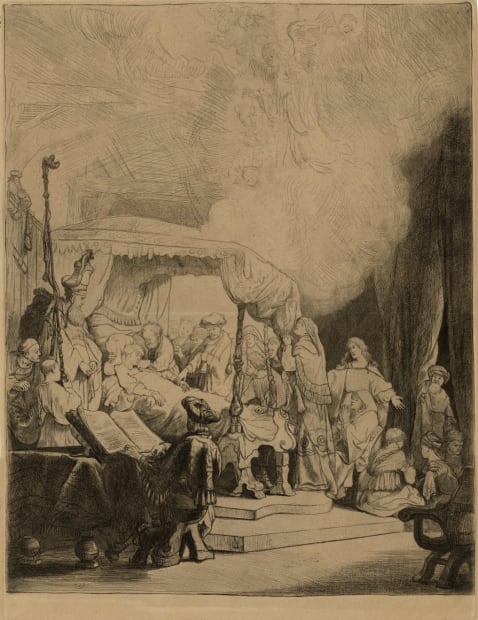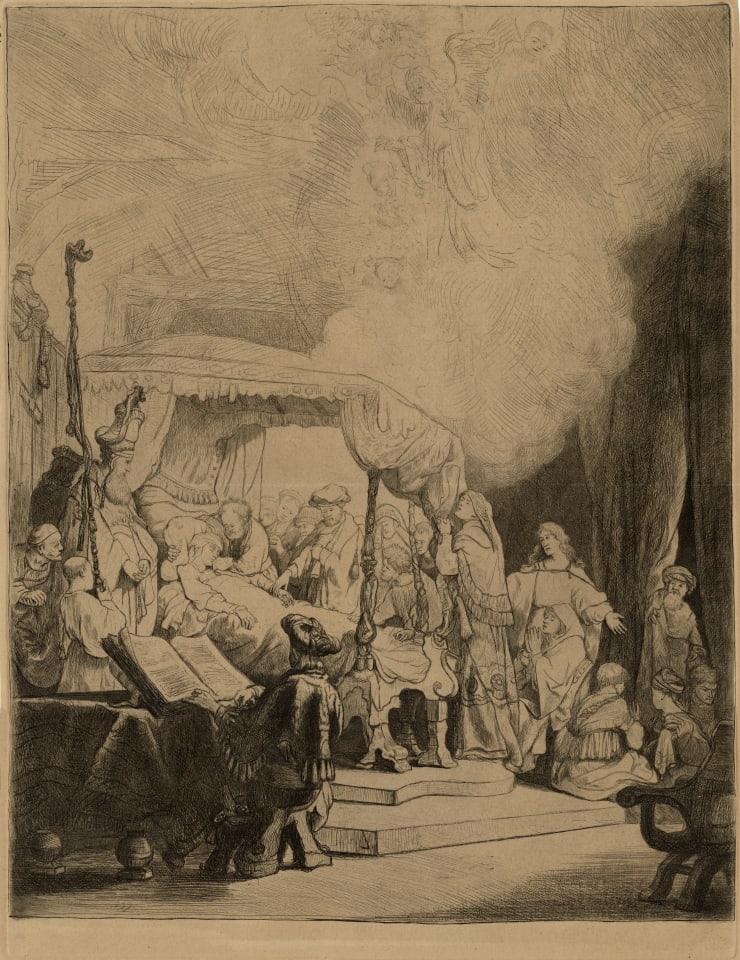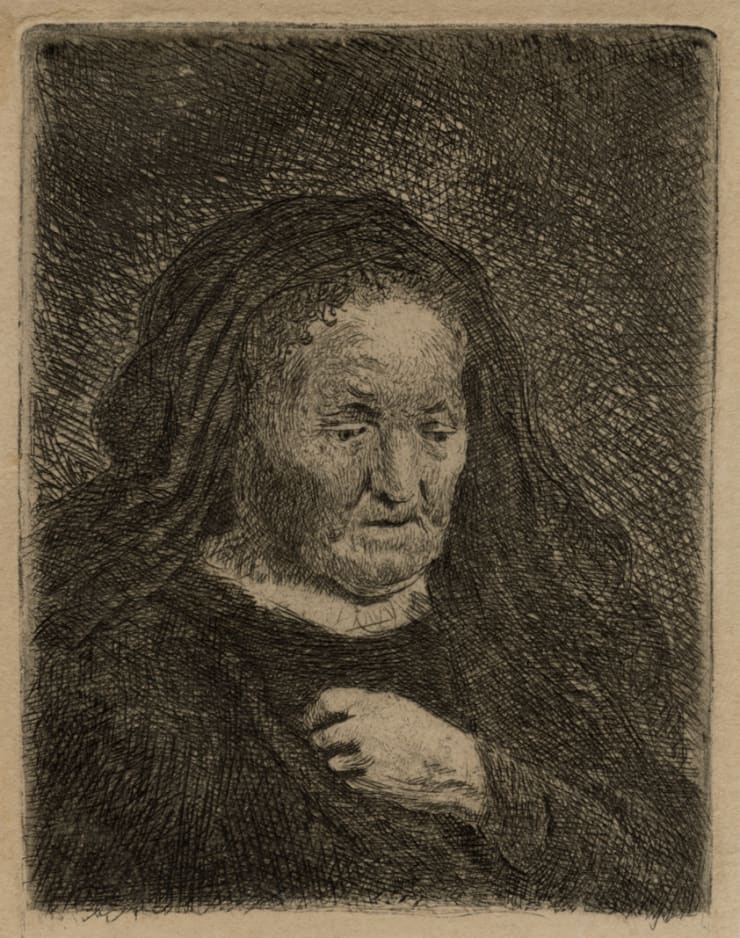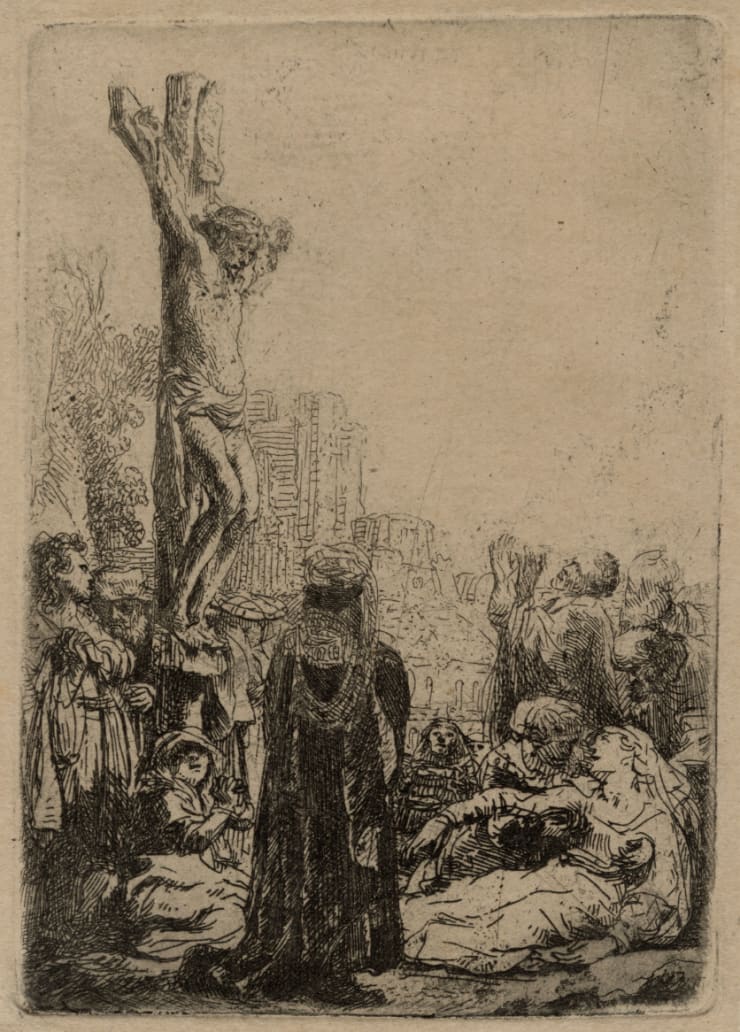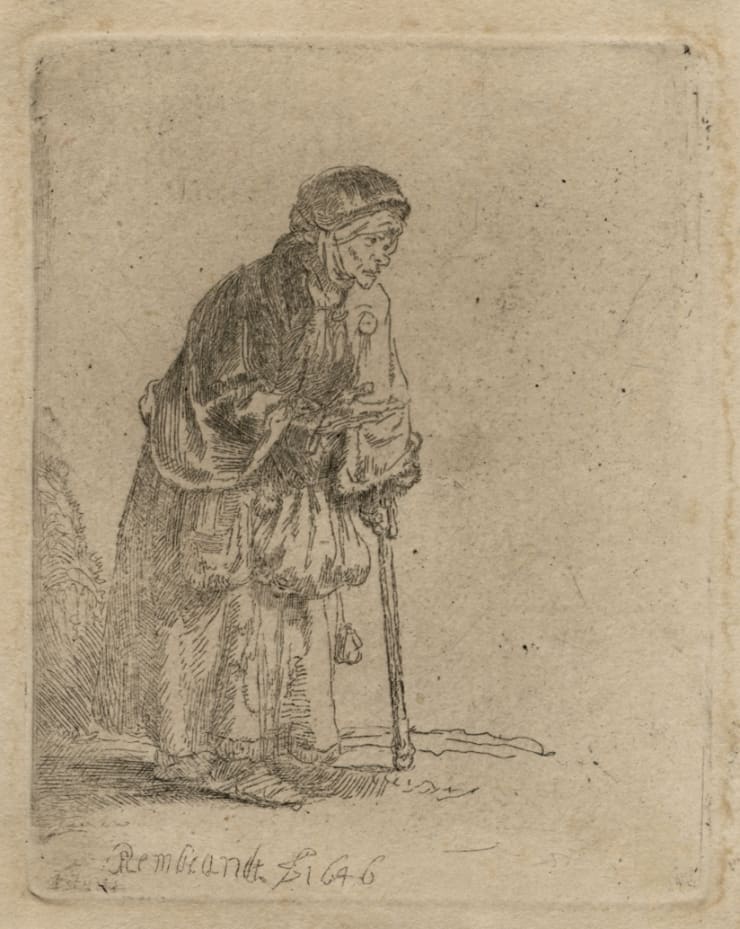-

The Death of the Virgin
-
To a large degree, it is via such printings that Rembrandt's extraordinary legacy as a printmaker was secured, enriched and propagated to a wider audience. In 1786, another Parisian printer and publisher, Pierre-Françoise Basan acquired 80 etching plates from the Watelet estate and published his own edition. The so-called 'Basan Recueil' ('recueil' translates as 'collection') was first published in 1789 and constituted a landmark, not only in the history of Rembrandt scholarship but also in the academic study of art. For the first time, a volume containing an overview of Rembrandt's work, printed from his own plates was available to the collecting public. After Basan's death in 1797, his son Henri Louis Basan inherited the plates and published his own collection of Rembrandt etchings in 1807/8. The H.L. Basan Edition is noted for the richness of impression and highly sought after. It is very rarely available to purchase.
It is half a decade since we were last able to display a collection of Rembrandt prints of comparable quality in the gallery. Regular visitors will be aware that, when possible, we like to complement our programme of shows by contemporary artists with offerings of masterworks by major artists from the printmaking tradition. Rembrandt has joined Picasso, Goya, Chagall, Matisse, Miró, Samuel Palmer and Dürer on the gallery walls in recent years and conducting an ongoing dialogue between contemporary art and the tradition that it comes from is central to what we do. We have found that Rembrandt has much to say to us and those who have been listening most closely are the etchers that we have the pleasure of working with as they make their own contribution to this story of print. Their words over the following pages are a testament to Rembrandt's enduring, telling and vital influence. It is a profound legacy and we are privileged to be able to share such masterful evidence of it - printed from his original copper plates - with you this winter.
* Christopher White, 'Rembrandt as an Etcher, A Study of the Artist at Work' 1969 p. 22
Vincent Eames, January 2022
We have also created a beautiful catalogue for the exhibition which can be viewed and purchased HERE.
-
MYCHAEL BARRATT
“Rembrandt has been my greatest inspiration since childhood when I was given his huge catalogue raisonné that I was too young to safely carry. My love of dramatic chiaroscuro and the use of crosshatching to build tones in my etchings are all down to spending countless hours absorbed by his work. Ultimately, it’s the heart and soul of Rembrandt that endures. This goes beyond favourite artists, I honestly believe he’s the greatest.”
Click HERE to see Mychael's related work and artist's page.
-
JASON HICKLIN
“The etchings of Rembrandt are never too far from my mind especially when I am in the etching workshop. His work is a reminder to be brave and not to be afraid to take risks; his decision making is there to be seen and if that decision was wrong he knew the escape routes. This could mean etching in new lines or scraping and burnishing away previously etched lines - working not just from white to black but also from black to white. This method became a balancing act between light and dark. Light is crucial in the etching process and within the darkest blacks of a Rembrandt etching often lurks a magical sparkle of white. Rembrandt always reminds me of the limitations and boundaries of the process etchers work within and push against. These etchings are achieved within the parameters of the hard ground and engraving process, the alchemical world of aquatint was an unknown and yet to be discovered process to this master of etching.”
Click HERE to view Jason's work
-
AMANDA DANICIC
“Rembrandt is a master draftsman; his work is so expressive and full of humanity, he almost occupies the subjects he depicts encouraging us to empathise with how they feel. He is the master of economy of mark making and I think his etchings have a beautiful fluidity to them which is rare, and enables him to cleverly depict the unseen, such as wind.”
Click HERE to view Amanda's work
-
BLAZE CYAN
“One of the things I most admire about Rembrandt is that he achieved so much with just the simplest of etching techniques... hard ground. He was an exceptionally skilled draftsman, his images seem effortless and yet the layers of drawing and the magical use of chiaroscuro give his work such incredible depth and atmosphere. I am always reminded about going back to basics, and start with drawing, my favourite quote from him resonates strongly with the belief I have about my own work.... ‘Choose only one master... nature’.”
Click HERE to view Blaze's work
-
EDWARD TWOHIG
“I find Rembrandt’s insightfully observed and humane etchings and drypoints a perpetual source of nourishment. Across my own printmaking Rembrandt is the lighthouse for his use of drypoint and also for making, sometimes quite dramatic changes, to plates in progress; creating new ‘states’ even while plates were being printed. The printmaker in me relishes Rembrandt’s deep-seated appreciation for the beauty of incised line as well as his complete mastery of it. Both do not diminish over time.”
Click HERE to see Edward's work
-
MILÁ FÜRSTOVÁ
"Rembrandt is an absolute master of building drama of velvety darkness to glowing lightness through the simplest means of an etched line. His line is tender, playful and it comes directly from his soul."
Click HERE to see Milá's work
-
NORMAN ACKROYD
“Holland in the first decades of the 1600s was the crucible for huge development in etching practice and innovation. New acid resisting grounds that took very fine needle work and new acids such as Dutch Mordant were invented at that time probably at the instigation of Rembrandt and one or two others.
That expertise and knowledge was brought to London by Wenceslas Hollar in the 1640s and began a terrific growth of interest and practice over here that endures to this day.”
Click HERE to see Norman's work
-
ANITA KLEIN
“Where to start about how Rembrandt has inspired me? From studying and copying his etchings in the print room at the British Museum when I was a student, to being moved to tears by the late paintings at the National Gallery a few years ago, Rembrandt stands head and shoulders above all other artists for me (maybe alongside Picasso) as a master of printmaking. His relentless correcting of his own work, each stage of his etchings fearlessly discarding beautiful drawing to delve deeper into his subject-matter, his masterful use of light and darkness, and his courageous inventiveness with etching and drypoint. But above all Rembrandt’s deep and sympathetic portrayal of human (and animal) frailty and emotion.”
Click HERE to see Anita's work
-
KAREN KEOGH
“I first saw Rembrandt’s etchings many years ago in Amsterdam. They are all about the light. I love the smaller more sketchy portraits. I was inspired to use more line work after seeing them.”
Click HERE to see Karen's work
-
AUSTIN COLE
“Rembrandt’s prints - the purity of his etched line and how he uses this line to build up tone - have always been the gold standard of etching for me.”
Click HERE to view Austin's work
-
SARAH GILLESPIE
“What to say about Rembrandt? He is the master. In 1658 late in his life - he made a tiny etching of a reclining nude seen from behind. It is one of my all- time favourite images. Painterly, dark, soft, mysterious; this tiny image has a power and an eroticism that defies its size.
Rembrandt thought nothing of mixing engraving, etching, mezzotint and drypoint. He worked freely with all the ’tools’ to hand in pursuit of his image. I think it’s this visible evidence of hand and heart, above all else, that give the etchings a life and a depth that still resonates now.”
Click HERE to view Sarah's work
-
VETA GORNER
“Rembrandt’s “Girl Sleeping” was on a cover of my first ‘how-to-draw’ book. Short of being a critical link in the story of the Western Art his is an adventurous and inquiring mind, and his work shows generations of artists not just how to draw but how to think.”
Click HERE to view Veta's work
Rembrandt
Past viewing_room
